|
|
|
Sort Order |
|
|
|
Items / Page
|
|
|
|
|
|
|
| Srl | Item |
| 1 |
ID:
124113
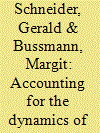

|
|
|
|
|
| Publication |
2013.
|
| Summary/Abstract |
This article presents the Konstanz One-Sided Violence Event Dataset (KOSVED) which allows researchers to study the dynamics of civilian abuse in 17 civil wars. The dataset provides, based on a multitude of sources, detailed information on the number of civilians killed or harmed by government or rebel troops. Where information is available, KOSVED also documents the dates of these events as well as the identities of the perpetrators and the means used in terrorizing the civilian population. The authors argue that the content analysis of news reports offers relatively accurate figures on those events that the perpetrators cannot hide from the public and that receive prominent media attention. Presumably, such information motivates potential short-term retaliatory acts by the group that has been the target of one-sided violence. The analysis suggests that, over the course of a conflict, almost all actors attack unarmed citizens, although to radically different degrees and relying on different means.
|
|
|
|
|
|
|
|
|
|
|
|
|
|
|
|
| 2 |
ID:
172329


|
|
|
|
|
| Summary/Abstract |
How does diffusion of civil war battles influence conflict termination? Recent advances in civil war literature have found that battle dynamics shape conflict termination by affecting the intra-conflict bargaining between disputants. This article extends the theoretical perspective and argues that how battles diffuse matters in determining conflict termination. While battlefield dynamics should in principle reveal previously unavailable private information, the relevance of information-revealing effect depends on the diffusion patterns of battles. The persistent, and possibly battle-exacerbated, commitment problem can also alter the prospects of conflict termination. We test the argument by distinguishing two distinct diffusion patterns of battles: distant and proximate. The empirical results reveal that distant diffusion, but not proximate diffusion, of battles makes civil conflicts less likely to terminate. The analysis also demonstrates that incorporating diffusion dynamics significantly improves our ability to predict conflict termination.
|
|
|
|
|
|
|
|
|
|
|
|
|
|
|
|
| 3 |
ID:
126802
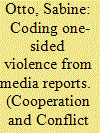

|
|
|
|
|
| Publication |
2013.
|
| Summary/Abstract |
Event datasets on political violence, which are comprised of coded collected news reports, have enjoyed a renaissance within the academic community. The inclusion of civilian fatalities within these datasets is a promising and welcomed advancement regarding the availability of data on one-sided violence. However, these datasets are often criticised due to their heavy reliance on media records, which may be tainted by biases. So far, little attention has been paid to the specific problems that arise in the coding procedure with respect to one-sided violence. This article addresses such difficulties by discussing particular challenges presented by media biases and by providing empirical evidence from coding one-sided violence. Furthermore, solutions and strategies are offered to the issues that could affect the coding process, including increased transparency, definition-adaptation, and the use of appropriate statistical models.
|
|
|
|
|
|
|
|
|
|
|
|
|
|
|
|
| 4 |
ID:
142490
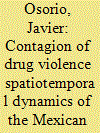

|
|
|
|
|
| Summary/Abstract |
Why are some territories ravaged by intense levels of criminal violence while others are relatively peaceful? This research contributes to an understanding of the escalation and diffusion of drug violence in Mexico from 2000 to 2010 by formalizing the interactions between the state and organized criminals and by relying on a large database of event data containing more than 1.6 million observations. Results based on spatial econometrics provide evidence of the spatial diffusion of violence. In congruence with the theoretical expectations, the results show that the disruptive effect of law enforcement is an important catalyst for the intensification of violence between criminal organizations, especially when deployed in areas hosting a high concentration of criminal groups. This relationship holds for a broad menu of violent and nonviolent law enforcement tactics. The analysis also reveals that other broadly held factors (international, geographic, and socioeconomic characteristics) have a modest effect on the dynamics of drug-related violence.
|
|
|
|
|
|
|
|
|
|
|
|
|
|
|
|
| 5 |
ID:
172176
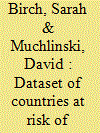

|
|
|
|
|
| Summary/Abstract |
Electoral violence is increasingly affecting elections around the world, yet researchers have been limited by a paucity of granular data on this phenomenon. This paper introduces and describes a new dataset of electoral violence—the Dataset of Countries at Risk of Electoral Violence (CREV)—that provides measures of 10 different types of electoral violence across 642 elections held around the globe between 1995 and 2013. The paper provides a detailed account of how and why the dataset was constructed, together with a replication of previous research on electoral violence. We introduce this dataset by demonstrating that the CREV, while measuring the same underlying phenomena as other datasets on electoral violence, provides researchers with the ability to draw more nuanced conclusions about the causes and consequences of violence that occurs in connection with the electoral process. We also present and analyze descriptive data from the CREV dataset.
|
|
|
|
|
|
|
|
|
|
|
|
|
|
|
|
| 6 |
ID:
178379
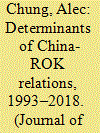

|
|
|
|
|
| Summary/Abstract |
This article seeks to explore the determinants of China-ROK relations during the period 1993–2018, employing event data and statistical analysis. The analysis found that China’s trade dependence on ROK, and vice versa, had a positive effect on China-ROK relations. The relations were also positively affected by China’s economic development. In contrast, the relations were negatively affected as China’s population aged and while conservative administrations governed ROK. The empirical findings of this article provide essential insights, identifying the factors that promote or hinder the development of cooperative China-ROK relations, suggesting guidelines to policymakers on both sides.
|
|
|
|
|
|
|
|
|
|
|
|
|
|
|
|
| 7 |
ID:
182676
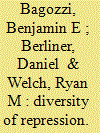

|
|
|
|
|
| Summary/Abstract |
Tactical repertoires of mobilization and repression play an essential role in understanding dynamics of political violence, yet existing quantitative approaches focus primarily on intensities or counts of repressive actions. We focus instead on the diversity of repression, and demonstrate a novel method of measuring repertoires of state repression using event data. We show that more repressive states are likely to employ more diverse repertoires of repression, rather than specializing narrowly in particularly coercive tactics. We demonstrate that, globally, repertoires of state repression are growing less diverse over time. Finally, in the Online appendix, we model repertoires of repression across countries and over time, finding evidence of broader repertoires during protest and civil war, but narrower under democratic regimes and international human rights treaties.
|
|
|
|
|
|
|
|
|
|
|
|
|
|
|
|
| 8 |
ID:
157770
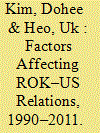

|
|
|
|
|
| Summary/Abstract |
This study investigates what factors affect Republic of Korea (South Korea)–United States (ROK–US) relations based on a theoretical framework, using event data created by content analysis from 1990 to 2011. South Korea’s economic development led to democratization, which resulted in elite changes. New progressive elites interpreted national interests differently and demanded changes in ROK–US relations. Accordingly, the ROK–US relationship was tense during the progressive administrations. ROK’s economic development attracted more trade with the US, which enhanced the bilateral relationship due to heightened interdependence. By contrast, the Democratic People’s Republic of Korea (North Korea)–US relationship and the trade between ROK and China did not significantly affect ROK– relations, meaning ROK’s relationship with other countries does not affect ROK–US relations.
|
|
|
|
|
|
|
|
|
|
|
|
|
|
|
|
| 9 |
ID:
175342
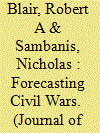

|
|
|
|
|
| Summary/Abstract |
Does theory contribute to forecasting accuracy? We use event data to show that a parsimonious model grounded in prominent theories of conflict escalation can forecast civil war onset with high accuracy and over shorter temporal windows than has generally been possible. Our forecasting model draws on “procedural” variables, building on insights from the contentious politics literature. We show that a procedural model outperforms more inductive, atheoretical alternatives and also outperforms models based on countries’ structural characteristics, which previously dominated models of civil war onset. We find that process can substitute for structure over short forecasting windows. We also find a more direct connection between theory and forecasting than is sometimes assumed, though we suggest that future researchers treat the value-added of theory for prediction not as an assumption but rather as a hypothesis to test.
|
|
|
|
|
|
|
|
|
|
|
|
|
|
|
|
| 10 |
ID:
126807
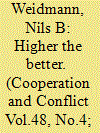

|
|
|
|
|
| Publication |
2013.
|
| Summary/Abstract |
The majority of conflict event datasets rely on media reports as their sole source of information. Because of the various difficulties associated with media reports, it is useful to compare conflict events based on them with those obtained from other observers. A paper published in 2010 by O'Loughlin and colleagues makes a first attempt to do this by using (1) a media-based event dataset and (2) military records on Afghanistan. While the authors conclude that the level of agreement between the two datasets is high, my results show that this goes away once we aggregate to finer analytical resolutions - those that are typically used in micro-level conflict analyses. Thus, rather than giving us the 'all-clear' for the accuracy and quality of media-based conflict data, my results once again point to the importance of robustness tests in quantitative conflict research, but also to the need to study the discrepancies in different reporting mechanisms to find out what they can and what they cannot tell us.
|
|
|
|
|
|
|
|
|
|
|
|
|
|
|
|
| 11 |
ID:
172192
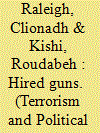

|
|
|
|
|
| Summary/Abstract |
Pro-government militias (PGMs) are armed, political organizations that assist regime and state elites through illicit violence. This article considers how and where to situate militias within larger frameworks of political violence and its emerging contexts. Pro-government militias have increased in recent years, along with their participation in conflict events, including those resulting in fatalities. This is in step with increases in domestic political competition and regime fragmentation across developing states. Using a new PGM dataset that collects discrete events perpetrated by these groups across Africa from 1997–2016, two conclusions are reached: PGM groups are more active outside of civil war periods than within, and their actions and numbers have increased as more countries transition to democracy. Further, activity by PGMs is not well explained by government attempts to delegate violence for reputational reasons or low capacity. Political fragmentation at the national level and diffuse opposition threats better account for the spatial and temporal patterns of PGM activity.
|
|
|
|
|
|
|
|
|
|
|
|
|
|
|
|
| 12 |
ID:
196004


|
|
|
|
|
| Summary/Abstract |
Social scientists do not directly study cyberattacks; they draw inferences from attack reports that are public and visible. Like human rights violations or war casualties, there are missing cyberattacks that researchers have not observed. The existing approach is to either ignore missing data and assume they do not exist or argue that reported attacks accurately represent the missing events. This article is the first to detail the steps between attack, discovery and public report to identify sources of bias in cyber data. Visibility bias presents significant inferential challenges for cybersecurity – some attacks are easy to observe or claimed by attackers, while others take a long time to surface or are carried out by actors seeking to hide their actions. The article argues that missing attacks in public reporting likely share features of reported attacks that take the longest to surface. It builds on datasets of cyberattacks by or against Five Eyes (an intelligence alliance composed of Australia, Canada, New Zealand, the United Kingdom and the United States) governments and adds new data on when attacks occurred, when the media first reported them, and the characteristics of attackers and techniques. Leveraging survival models, it demonstrates how the delay between attack and disclosure depends on both the attacker’s identity (state or non-state) and the technical characteristics of the attack (whether it targets information confidentiality, integrity, or availability). The article argues that missing cybersecurity events are least likely to be carried out by non-state actors or target information availability. Our understanding of ‘persistent engagement,’ relative capabilities, ‘intelligence contests’ and cyber coercion rely on accurately measuring restraint. This article’s findings cast significant doubt on whether researchers have accurately measured and observed restraint, and informs how others should consider external validity. This article has implications for our understanding of data bias, empirical cybersecurity research and secrecy in international relations.
|
|
|
|
|
|
|
|
|
|
|
|
|
|
|
|
| 13 |
ID:
165889
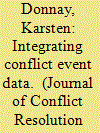

|
|
|
|
|
| Summary/Abstract |
The growing multitude of sophisticated event-level data collection enables novel analyses of conflict. Even when multiple event data sets are available, researchers tend to rely on only one. We instead advocate integrating information from multiple event data sets. The advantages include facilitating analysis of relationships between different types of conflict, providing more comprehensive empirical measurement, and evaluating the relative coverage and quality of data sets. Existing integration efforts have been performed manually, with significant limitations. Therefore, we introduce Matching Event Data by Location, Time and Type (MELTT)—an automated, transparent, reproducible methodology for integrating event data sets. For the cases of Nigeria 2011, South Sudan 2015, and Libya 2014, we show that using MELTT to integrate data from four leading conflict event data sets (Uppsala Conflict Data Project–Georeferenced Event Data, Armed Conflict Location and Event Data, Social Conflict Analysis Database, and Global Terrorism Database) provides a more complete picture of conflict. We also apply multiple systems estimation to show that each of these data sets has substantial missingness in coverage.
|
|
|
|
|
|
|
|
|
|
|
|
|
|
|
|
| 14 |
ID:
124980
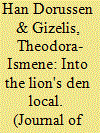

|
|
|
|
|
| Publication |
2013.
|
| Summary/Abstract |
Multidimensional peacekeeping has drawn the United Nations (UN) into state-building, and missions have taken on significant responsibilities for good governance. Since it aims at transforming states from fragile post-conflict situations into inclusive, well-governed societies, multidimensional peacekeeping is more complex and arguably also more contentious than traditional peacekeeping. Multidimensional peacekeeping affects the balance of power between the government and rebels and provides them with opportunities for rent-seeking. Although the potential gains are obvious, the process is bound to lead to uncertainty and controversy. Whereas the international community mainly appreciates the opportunity of comprehensive peacekeeping to create value, local actors may be more concerned with opportunities for claiming value. What will be the responses of local actors to peacekeeping given the likely impact on the distribution of power between rebels and governments and their uneven opportunities to benefit from collaborating? Using event data for post-Cold War UN peacekeeping missions in Africa, the analysis considers when peacekeeping elicits cooperation rather than conflict, focusing on (a) the authorities involved in the event, (b) the policies implemented, and (c) the role of the peacekeepers. Key findings are that government authorities are more likely to respond cooperatively to peacekeeping actions, while rebels are more likely to respond with hostility. Both the government and rebels are unlikely to contest policies that aim to strengthen state capacity, while both are more likely to contest human rights policies. Finally, rebels tend to respond more cooperatively when peacekeepers have a mainly supportive role.
|
|
|
|
|
|
|
|
|
|
|
|
|
|
|
|
| 15 |
ID:
183151
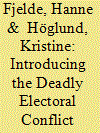

|
|
|
|
|
| Summary/Abstract |
This article introduces the Deadly Electoral Conflict dataset (DECO): a global, georeferenced event dataset on electoral violence with lethal outcomes from 1989 to 2017. DECO allows for empirical evaluation of theories relating to the timing, location, and dynamics of deadly electoral violence. By clearly distinguishing electoral violence from related (and sometimes concurrent) instances of organized violence, DECO is particularly suitable for investigating how election-related violence is connected to other forms of violent political contention. In the article, we present the theoretical and methodological underpinnings of the data collection and discuss empirical patterns that emerge in DECO. We also demonstrate one potential use of DECO by examining the association between United Nations peacekeeping forces and the prevalence of deadly electoral violence in conflict-affected countries.
|
|
|
|
|
|
|
|
|
|
|
|
|
|
|
|
| 16 |
ID:
157588
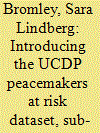

|
|
|
|
|
| Summary/Abstract |
This article introduces new event data on violence against peacekeepers deployed to conflict-affected countries in sub-Saharan Africa between 1989 and 2009. While the practice of peacekeeping is often described as fraught with risk, a shortage of data has left scholars poorly equipped to study this important phenomenon. The Peacemakers at Risk (PAR) dataset records reported incidences of violence resulting in direct peacekeeping personnel fatalities, injuries and kidnappings. Information on the timing, location, outcomes and actors implicated is provided for each recorded event, including information on the nationalities of violence-affected peacekeepers. The dataset also charts reports of fatal violence by peacekeepers. This enables the study of peacekeepers’ use of force and provides a new lens for examining wider questions related to peacekeeping effects and conflict dynamics. Peace operations deployed by the UN as well as other peacekeeping actors are included, allowing for a rich dataset that reflects today’s diverse peacekeeping landscape. The PAR dataset makes possible the evaluation of reigning assumptions regarding peacekeeping intervention and risk, and allows scholars to pose research questions regarding the causes, characteristics and consequences of peacekeeper violence, within and across interventions. This article introduces the criteria and procedures guiding the data collection and presents the data. The article also highlights key patterns emerging from the dataset and identifies a number of potential applications and avenues for future research.
|
|
|
|
|
|
|
|
|
|
|
|
|
|
|
|
| 17 |
ID:
167285
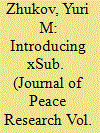

|
|
|
|
|
| Summary/Abstract |
Researchers today have access to an unprecedented amount of geo-referenced, disaggregated data on political conflict. Because these new data sources use disparate event typologies and units of analysis, findings are rarely comparable across studies. As a result, we are unable to answer basic questions like ‘what does conflict A tell us about conflict B?’ This article introduces xSub – a ‘database of databases’ for disaggregated research on political conflict (www.x-sub.org). xSub reduces barriers to comparative subnational research, by empowering researchers to quickly construct custom, analysis-ready datasets. xSub currently features subnational data on conflict in 156 countries, from 21 sources, including large data collections and data from individual scholars. To facilitate comparisons across countries and sources, xSub organizes these data into consistent event categories, actors, spatial units (country, province, district, grid cell, electoral constituency), and time units (year, month, week, and day). This article introduces xSub and illustrates its potential, by investigating the impact of repression on dissent across thousands of subnational datasets.
|
|
|
|
|
|
|
|
|
|
|
|
|
|
|
|
| 18 |
ID:
162767


|
|
|
|
|
| Summary/Abstract |
Machine-coded event datasets have become popular in conflict research. I argue that systematic media biases render news-based event data unsuitable for studying networks of insurgents and political parties. Insurgent networks are too secretive to be captured by media reports, whereas alliances among regular political parties are too constant to be considered newsworthy. I analyze the data accuracy of the network study of insurgents and political parties in Thailand by Metternich et al. (2013), which is based on the most comprehensive event dataset currently available: Lockheed Martin's International Crisis Early Warning System (ICEWS) project. Using simple evaluation criteria, I show that most of the network data entries are incorrect, leading to a depiction of the networks that is unrelated to real-world cleavages in Thailand. While my hand-coded event dataset captures relatively more network-relevant information than ICEWS, the comparison confirms that journalists specifically underreport cooperative events among insurgents and parties. In addition, the ICEWS project provides unreliable counts of conflictual events in Thailand. Using alternative conflict measurements from the Deep South Watch dataset and a dummy variable based on established periods of unrest, I show that violent activities in Thailand's Deep South declined during periods of conflict between pro- and anti-Thaksin groups. Conflicts were unrelated to network fragmentation, contradicting the primary finding of Metternich et al.
|
|
|
|
|
|
|
|
|
|
|
|
|
|
|
|
| 19 |
ID:
157582
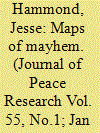

|
|
|
|
|
| Summary/Abstract |
Disaggregated studies of civil violence attempt to predict where violence is most likely to break out within states, but have been limited by a near-exclusive focus on political, economic, and accessibility-based factors in explaining local patterns of violence. These factors are important, but the calculus of military conflict does not focus solely on lootable resources or population distributions. Both states and insurgents try to exert control over geographic territory in order to increase their resource base and political legitimacy. Historic evidence suggests that groups use violence to contest control over strategically important locations that allow them to effectively attack and defend territory. I use GIS and social network analysis to operationalize strategic location based on the network of roads and population settlements that make up a country. I find that during conflicts, locations with high degree and betweenness centrality in the road network – in other words, locations that control access to other areas within the state – are significantly more likely to be fought over, even after controlling for a wide range of variables suggested by previous literature and testing for reporting bias. These findings expand on the previous body of literature studying disaggregated violence and show that the calculus of violence during civil conflict encompasses strategic considerations as well as economic, political, or topographic factors.
|
|
|
|
|
|
|
|
|
|
|
|
|
|
|
|
| 20 |
ID:
183698
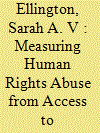

|
|
|
|
|
| Summary/Abstract |
Existing measures of human rights abuses are often only available at the country-year level. Several more fine-grained measures exhibit spatio-temporal inaccuracies or reporting biases due to the primary sources upon which they rely. To address these challenges, and to increase the diversity of available human rights measures more generally, this study provides the first quantitative effort to measure human rights abuses from textual records of citizen-government interactions. Using a dataset encompassing over 1.5 million access-to-information (ATI) requests made to the Mexican federal government from June 2003 onward, supervised classification is used to identify the subset of these requests that pertain to human rights abuses of various types. The results from this supervised machine learning exercise are validated against (i) gold standard ATI requests pertaining to past human rights abuses in Mexico and (ii) several accepted external measures of sub-national and sub-annual human rights abuses. In doing so, we demonstrate that the measurement of human rights abuses from citizen-submitted ATI request texts can provide measures of human rights abuse that exhibit both high validity and notable spatio-temporal specificity, relative to existent human rights datasets and variables.
|
|
|
|
|
|
|
|
|
|
|
|
|
|
|
|
|
|
|
|
|